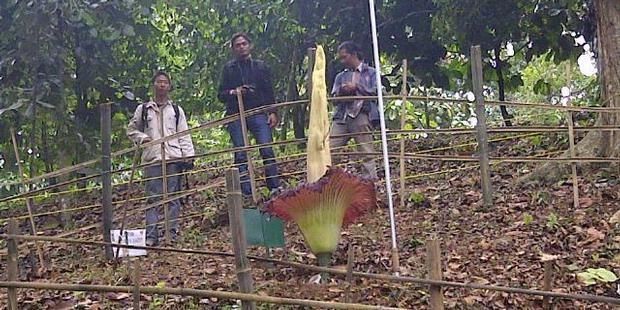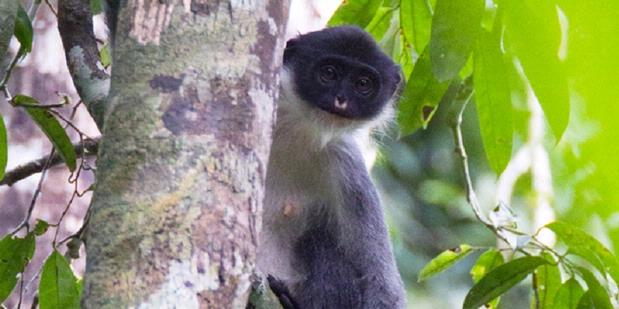 |
Visitors of corpse flower (Amorphophalus titanum) in Bogor Botanical Garden,
West Java, on Wednesday (30/11/2011) |
Bogor - Kebun Raya Bogor (Bogor Botanical Garden) will cooperate with an international horticulture organization from South Korea for preservating a species of corpse flower,
Amorphophallus titanum.
"So far this corpse flower just grown up, blooming, withered and dormant. That's all. Therefore, we will try to work closely with South Korea for preserving this flower in order to public can see the interestof this flower when blooming," said
Yuzammi, a researcher of corpse flower from Bogor Botanical Gardens in a press conference, Friday (27/1/2012) in Bogor.
The cooperation came out with respect to a requests to fulfill the Indonesia pavilion in a flower exhibition in South Korea.
Amorphophallus titanum became one of the flowers which dated, but difficult to show off because its blooming age is very short. Then preservation is needed.
Cooperation effort pursued because of the preserving difficulty measures such as giant Amorphophallus titanum.
"It's a lot of preservation techniques. But we have to find the way how to the preservation dont change the original colour of the flower. This is one of the barriers that must be solved through research," said Yuzammi.
The processed flower later will be displayed in a transparent container. It will be a wet
herbarium, so it will appear as plant in an aquarium containing a chemical preservative.
"For this step, there is so much of the technical barriers that make us have to work together. This giant-sized flowers that we have to find a giant container that can also shore up this interest. It also would have required large amounts of chemicals," says
Dra. Sofi Mursidawati M.Sc. who also a researcher at the Bogor Botanical Garden.
Cooperation plan has not yet been signed, but now has already an intense contact with South Korea party. Meanwhile, the flower that will be the object of preservation is Amorphophallus titanum at Bogor Botanical Garden that will bloom in a few days ahead. When in bloom, the flowers will be deducted and transferred to the container for preserved.
At first glance, this preservation effort impressed detrimental. However, Sofi revealed that the efforts have to be done." We have to think differently. Not locked up on one's point of view," decisively Sofi. Through the efforts of preservation, various studies on Amorphophallus can be done too.
"If we made it, we can try to do on the type of the other giant flowers. In Indonesia there is also a giant Orchid, we will also be able to do these type of preservation," She said.
Preservation can also be used for the benefit of public awareness of biological diversity in Indonesia as well as non-scientific benefit.
"In the future, the preservation collection can be in the museum, enjoyed by a lot of people. In addition it may also be used as a state presenting. The President could give to another head of state. This will be its own prestige," said Sofi.
As an attempt "to change" the cutted individual, Sofi and her partner also researched for propagation of Amorphophallus titanium. Now there are hundreds seed of these type obtained through tissue culture.
In collaboration with preserving, Sofi and colleagues propose that the process be done in Indonesia. Thus, many parties from Indonesia who can learn about the technique of preserving a giant flower.
Unknown yet, how old the blooming age that can be achieved after the preserved. However, the experience of Japan, the processed Rafflesia flowers can reach up to 3 years. Amorphophallus titanum including rare flower in Indonesia.
This flower is one of 18 species of endemic corpse flower in the country. The individual flowers are also getting more and more difficult to find.
source :
http://sains.kompas.com/read/2012/01/27/18310738/














